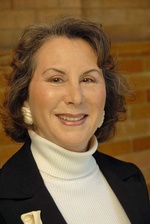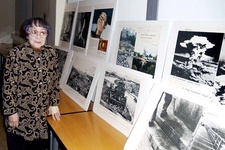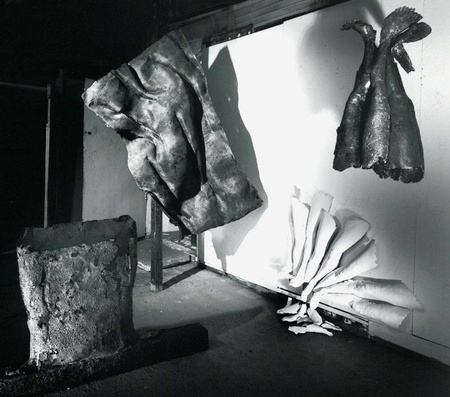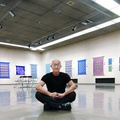Why pick up a paint brush, choose a camera lens, struggle over new computer software, or the latest in hip-hop-rock-blues beats? Why toil over architectural theories and algorithms, decide on the temperature of a kiln or which perspectives, points of view or editorial slants? What difference does it make now, or will it make in the grander scheme of things?
“It’s never enough to sit in your studio and make works of art for commerce. To use one’s life and one’s skills for promoting a rich and sustainable future is what art is really about. Art is never literal and finite. Each individual, and individuals over time, must bring their own experiences to the work, be touched by it, and moved to draw meaning, to grow, and to act upon the lessons learned from it and the exchange with others that grows out of it.” So says internationally recognized Fine Artist, Sandy Bleifer.
Sandy Bleifer operates mindfully in the conditions of 21st century rapid change. She evaluates daily, monthly, annual and decade change with the tools of her work ethic and disciplined art process. Thus the biological and social transformations she’s studied in her lifetime of art making, her probing into institutional infrastructures and the schisms of myriad belief systems are focused in this exhibit of the art, sprung from emotions that welled up in her in 1983, during her first visit to Japan, when she first confronted the devastation wreaked by the bombings of Hiroshima and Nagasaki in 1945.
Sandy describes her journey into the Hiroshima/Nagasaki Memorial Project as her venture into “discovering the connection between the creation of visual artworks and the creation of other art forms such as music, dance, theater, and even mathematics and science. This epiphany resulted in Bleifer’s grandest discovery of all, “that paper can express the human condition.”
She says she processed her initial feelings, not as a political statement, but just to work with her hands and the paper to help her process her own emotional response to this unimaginable revelation of man’s inhumanity to man. Basic truths deep inside her emerged in the process of creating the paper sculptures, structured on her own body. Bleifer speaks of her artistic heritage and bent as an arts activist. “The use of art for social change is a concept deeply embedded in my Western/European roots (e.g. Goya, Picasso, etc...) I used to think I was influenced by Japanese art because of my admiration for their textiles and graphic works. However, after studying Ikebana (flower arranging) and traveling to Japan to study, I recognize that my frame of reference and underlying aesthetics are totally Western. Not only compositionally, but in my approach to the use of the materials I work with. I do not try to follow earlier masters, but always look to discover the secrets of the medium myself and push the potentials."
She confronts the pressures of a world where one is overrun by technology and megabytes developing and fragmenting faster than the human mind can contemplate, a world where social networking constructs and deconstructs in a matter of days. She confronts the erosive cyber forces that exhaust and pare one down, as she seeks in her work to reveal “the naked truth that we are all the same under the skin; all in this process together.”
Her artwork challenges those who participate in it to befriend and to be family with each other. It suggests that only by uniting as One People/One Nation/One Globe, to serve the greater good, can the individual confront the challenges of fear, prejudice, superstition, scarcity mentality, ignorance and chaos wrought by unmanaged rapid change.
This is the message in the intimacy of the marriage between Sandy Bleifer and the paper she pulps into the medium from which she sculpts the fragility of the flesh. Bleifer sees with a rare transparency combined with an indomitable human spirit. Her work reveals the naked truth of who we are as the Human Race, and the choices we’re free to make to determine the outcome of our decisions.
When she saw others resonating to her work, reflecting her own emotions, Sandy began to think of touring the exhibit. This took the project to a higher level of process – actually coordinating other people, not just her own emotions and art tools – to carry on the exploration and to discover more about the complex process of healing and preventing this unimaginable devastation, this social cancer of cells killing cells within the body politic.
In the process, Sandy confronted the reality that our contemporary social order requires one to be as hard as granite on the outside, while we all know the psyche is cracking under the pressure of audits, deadlines, next quarter quotas and myriad other deadlines that must be met. The friends she made during the Project, shared and lifted the burdens of organizing the tour.
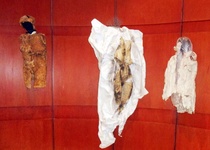
Sandy Bleifer’s work that framed this Tea Ceremony and will frame all events through February at the IGM AG
The Hiroshima/Nagasaki Memorial Project began with the idea of “taking my art works to a series of cities as a conveyor of humanitarian issues.” Her vision of an artistically shared experience, centered on a point in history, accomplishes her intent and broadens the dialog on present day concerns about “nuclear threats by rogue nations and the attraction of nuclear energy in the face of issues with fossil fuels.”
She hopes the exhibit will spark open-minded discussion that will result in substantive civic action in the areas of legislation, education and citizen diplomacy. She intends it to provide opportunities for further artistic expression, in all forms, to unite the global family in dividing and conquering the fear, superstition, prejudice, scarcity mentality and chaos that have traditionally led to the cells of the body politic turning upon each other in mortal combat.
“It is readily understood, she says, that for Japan there is a reality unto its own. As victims of the bombs, they live daily with the painful memories of loss, injuries and catastrophic experiences of war. Their perspective clearly contrasts to a world which withholds compassion out of face-saving and political posturing, a world that chooses to ignore subjects that could possibly sidetrack economic ambitions.”
Bleifer’s Hiroshima/Nagasaki Memorial Project, shown fifteen years ago at the 50th anniversary of the bombings, is being reworked now with the intent “to transcend cultural and language barriers to unite audiences in Japan and the U.S. for a shared experience of sorrow and compassion.” Organizing now, for exhibit at the USC Institute for Genetic Medicine Art Gallery on the University of Southern California’s Health Sciences Campus, it will embody the genius of an artist to manipulate and express the subtleties of paper, flesh and the truth within. Her sculptures, crafted from a wet, malleable paper medium, express theme and variation in visual form in this series of perspectives of body parts.
Hers is not a single ideal, a single sculpture that presents all in one, but a series of series that allows entry into the holistic reality though a number of portals prompting open-minded discussion. In this arena the Memorial Project peels back a new reality as the survivors of the bombings age and diminish in number. The Project now sends forth the urgent message that “if the world is to survive, it will do so more out of fear of a nuclear holocaust than a passive wish for peace.”
The exhibit at the IGM Art Gallery intends to prompt discussion from many points of view that will converge in a strategic plan for collaborative, positive action to heal the pain of the past and to prevent fear-based violent response that is mindless to catastrophic unintended consequences.
Most artists’ mediums are tools and venues outside of themselves--acrylics, charcoal, violins, harps, protractors, and easels. Bleifer however used her own body parts as profiles in her artwork. She chose the recurring theme of her legs because artistically the leg form all by itself is not racial or gender specific thus enabling the artist to depict the universality of the tragedies of war. The series of “costumes” on manikins is intended to invite the viewers to imagine themselves as one with the war victims by envisioning themselves donning the skins of devastation. Bleifer’s overriding theme throughout her creation is WHAT HAPPENS TO THE PEOPLE?” She humbly states, “That is why the exhibit looks the way it looks.” When confronted with the nuances of intent, legacy, and being pigeonholed, Bleifer’s position brings to mind an old traditional black Gospel song by Sullivan S. Pugh, as recorded by the Consolers:
“May the work I’ve done speak for me.
When I’m resting in my grave,
There is nothing that can be said.
May the work I’ve done speak for me
* Contact yolanthapace@gmail.com for reprint permission.
© 2010 Yolantha Harrison-Pace *All Rights Reserved


